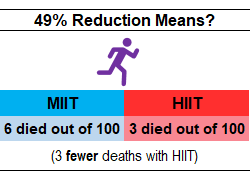Great article Anoop! Helping breakdown the truth! Good work!
Generation 100 study - Can higher intensity exercise lower deaths in older adults?
December 25 2020
The benefits of exercise on mortality are largely from observation studies and hence simply associations. The Generation 100 study, published in BMJ, will be the first large randomised clinical trial (RCT) to study effects of supervised, higher-intensity exercise on longevity over a 5-year period.

What was the population?
Older adults living in Trondheim, Norway, aged 70-77 years.
What were the interventions?
- Control group: were asked to follow the Norwegian physical activity guidelines, which is apparently 30 min of moderate level physical activity 7 days/week. The activities included either walking/running, skiing and aerobics.
- High-Intensity Interval Training (HIIT): Exchanged two of the five 30-minute moderate intensity physical activity sessions each week with two HIIT sessions. 40 minute sessions, 10 minute warm-up followed by 4×4 minute intervals (3 min active rest) at about 90% of peak heart rate (RPE: 16 on the Borg scale).
- Moderate Intensity Training (MIT): Exchanged 2 of the five 30 min sessions with 2 MIT sessions: 50 minutes of continuous work, 70% of peak heart rate corresponding to an (RPE:13)
Every 6th wk supervised spinning sessions (cycling) with an exercise physiologist were provided with intensity monitored using heart rate monitors. Supervised training with exercise physiologists was also offered twice a week in different outdoor areas. The control group was not supervised.
What were the results?
- No Difference: Unfortunately, the study failed to show a difference between the control group and combined (MIT +HIIT) group as hypothesized. Or showed a miniscule 0.2% difference in deaths.
- HIIT better: Interestingly, from the abstract, the authors states “a lower mortality ‘trend’ after HIIT compared with controls and MIT”
So why did the study fail?
- Healthy participant bias: So the big question is why did the study fail to show a difference? According to the authors under “Limitations”, this was largely because the majority of the participants were healthy and active. For instance, 80% of the participants had a high level of physical activity before joining the study. And this meant there were way low number of deaths than the authors had expected. They estimated around 10% deaths (2%/year) in the control group, but ended up with 4.7%. They also expected a 10% reduction in deaths, but ended up with 0.2%!!
- I partially agree with the authors, but it just kills me to know that they didn’t think about it prior to planning the study. 90% of the elderly who show up for an exercise study are healthier and highly active than the general population. In fact, The LIFE study, a similar study, which looked at an exercie program in elderly for 3 years excluded high functioning folks to avoid this exact problem. To put it bluntly, even before they recruited the first participant, the study was destined to fail.
- Low adherence: Another limitation according to the authors was that only 50% of the participants were able to follow the HIIT protocol (same for MIT too). But in my opinion, the low adherence to HIIT is just a reflection of how hard it is for people to exercise at higher intensities. Also, the researchers say that the control group exercised at an intensity between HIT and MIIT. If indeed they expected a higher adherence/no cross-contamination, that just means the study failed to meet their intervention targets, which questions the implementation or the intervention fidelity.
- The missing pilot study: Could have they have done anything different? Yes. IMO, these are some of the very reasons why a pilot study is so crucial before carrying out large study. A major reason for the success of the LIFE study is that they conducted a 1-year pilot study with around 400 people that showed informed how many will get disabled, the adherence, side effects, and so forth.
Was high intensity training really better??
In the abstract, the authors state that they observed “a lower mortality “trend” (non-significant) after HIIT compared with controls (37%) and MICT (49%)”. It means they observed a large reduction in mortality for the HIIT group although it wasn’t statistically significant”. And several leading news channels have reported this study to show HIIT as beneficial.
- 49% reduction in mortality??: A 49% reduction in deaths in HIT compared to MIT sounds huge, but is it really? A better way to understand risk is using natural frequencies. So, out of 100 people who did MIIT, 6 died, while those doing HIT, 3 died; means there will be just 3 fewer deaths if people did HIT compared to MIT in 5 years. So just a very small/trivial reduction that many won’t bother worrying about!
- Large uncertainty: If you look at the confidence interval, this decrease in deaths could be as low as 1 death in 100, no difference, or it could be even an increase in deaths (7/100)!! This lack of precision or large uncertainty is concerning. So a small/trivial effect and that too very uncertain (or non-significant).
Exploratory analysis: HIIT compared to MIIT and control group are just exploratory analysis. In other words, these weren’t pre-specified in the protocol plan, not even as a secondary analysis. Considering the 3 groups and over 20 secondary outcomes, the statistical comparisons could be easily over 100! So these results could be erroneous and simply due to chance.
The fact that MIT showed a 26% increase in deaths (yes an increase) “trend” compared to control is ignored shows why this practice is called ‘cherry picking’ - selectively picking analysis that favors your conclusion, and is officially called a “spin”.- Drop-outs & side effects: Drops outs and side effects in exercise trials are important. Drop outs were 33% in the HIIT compared to 26% in the MIIT. This differential drop out (10% higher in HIIT) is concerning and could be due the higher-intensity, but no reasons were reported. Adverse or side effects are a major concern with higher-intensities in elderly and should have been a pre-registered, statistically analyzed outcome. But no major difference is seen in adverse events reported.
- Quality of life (QOL): QOL of life showed a trivial, yet significant improvement with HIT. Or not a big enough effect to really bother about.

And I have to say this: the article reads like an exercise study in the Introduction, but gradually morphs into a study trying so hard to justify HIT or why HIT wasn’t significant here.
Blah blah… Should I do higher intensity exercise to reduce mortality?
- Based on the registered primary outcome, the study failed to show that intensity had any effect on mortality.
- What about HIIT? Contrary to the authors and popular media, based on the the exploratory nature of the analysis, the trivial/very small effect, and large uncertainty, we can only have a low or very low confidence in the results. You can save “10 minutes” of workout time, but you will have to endure the discomfort of higher intensity, and also risk a higher likelihood of dropping out.
- And all this means the decision to exercise at higher intensity to reduce mortality is more of a personal choice and cannot be offered as a general recommendation across the board. So pick the intensity you like please!





